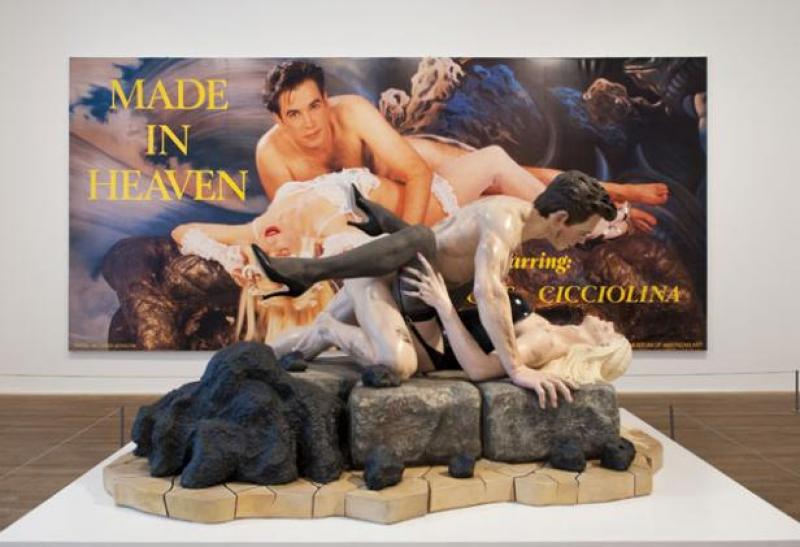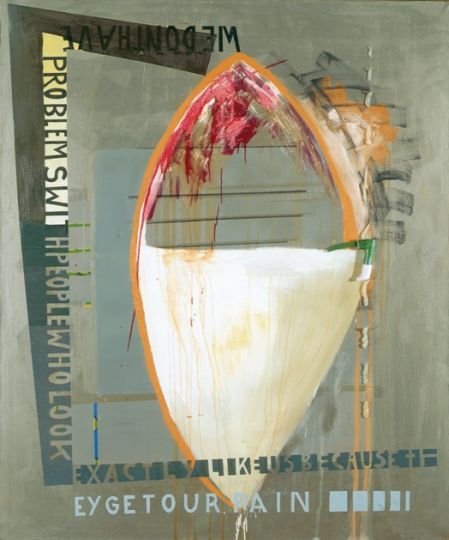Pop Life: Art in a Material World, Tate Modern | reviews, news & interviews
Pop Life: Art in a Material World, Tate Modern
Pop Life: Art in a Material World, Tate Modern
Money. Porn. Pop. Art. Tate.

That artists didn't just respond to the rapacious commercialism of the late 20th century, but actively contributed to it is hardly news. That the marketing of art can be part of the art itself is something everyone now implicitly understands, even if it’s only through hearing Tracey Emin wittering about herself on television.
Yet if the fact that Tate Modern has chosen to base its major autumn exhibition around such chronically over-exposed figures as Emin, Damien Hirst and Jeff Koons seems at first almost incredible, such reservations recede as you enter the show. Where most exhibitions of contemporary art leave acres of tasteful space around the work, this one packs it to the rafters department store-style. With hip-hop thundering from Keith Haring’s seminal Pop Shop installation, Japanese bubblegum blaring from the room devoted to Takashi Murakami’s manga art, your first impression is of a brash, rackety, but superbly stylish presentation that really does evoke the energy of the age of Monetarism, Madonna and Margaret Thatcher.
And if the noise doesn’t knock you sideways, the sex probably will. Richard Prince’s Spiritual America, featuring a photograph of a naked 10-year-old Brooke Shields, has been removed on the insistence of the police, but you’re still left with Jeff Koons’s billboard-size cum shots and a whole room devoted to British performance artist Cosey Fanni Tutti’s splayed vulva.
Taking its starting point from Andy Warhol’s notorious dictum that "good business is the best art", Pop Life recreates key moments in the process whereby artists went from being isolated studio-bound visionaries to mass media operators and multi-millionaire entrepreneurs with globally identifiable brand identities. Among other epoch-defining exhibits we revisit Koons’s Made in Heaven, celebrating his marriage to porn star-turned-politician Ilona Staller aka La Cicciolina in 1989, Martin Kippenberger’s hugely influential self-curated retrospective from 1993 and Damien Hirst’s straight-from-the-studio sale at Sothebys, held less than a year ago.
If the show’s rationale is a touch specious – artists have always been intensely preoccupied with money and have been manipulating their images at least since the Renaissance – its triumph is to make material that should feel well past its sell-by-date seem fresh and immediate.
Yet beyond the razzamatazz what really are we being offered here? It’s all very well seeing an exhibition like this at the press view, as I did, packed to the gills, with Koons smiling a mile wide for the world’s cameras. But what’s it going to be like on a benighted midweek afternoon with only a handful of people present?
The Warhol material, and there are three rooms of it, comes from the latter part of his career when, rather than looking in on pop culture from the outside, he was producing it himself: through celebrity magazine publishing, junk TV and by-the-yard portraiture. This is essentially the same material that was comprehensively rubbished in the media when showcased in last year’s Other Voices, Other Rooms at the Hayward, and while handsomely presented, it’s easy to pass by as just more "Warhol stuff".
Keith Haring’s hyperactive, graffiti-inspired doodling achieved a street-level popularity that outshone even Warhol’s and did a great deal to raise awareness of Aids, of which Haring himself died in 1990. It is also completely vacuous.
 Against these attempts to establish a single instantly identifiable style, German artist Martin Kippenberger – another casualty of the era, who died in 1997 – moved between media and idioms in a way that made him one of the most elusive, but interesting figures of the period. If his display’s emphasis on painting and drawing makes him appear a touch Old World in this relentlessly neophiliac context, he made very little of this work himself. The social character of his work, the way he got friends to make his art and showed their work as an aspect of his own, feels very symptomatic of the era.
Against these attempts to establish a single instantly identifiable style, German artist Martin Kippenberger – another casualty of the era, who died in 1997 – moved between media and idioms in a way that made him one of the most elusive, but interesting figures of the period. If his display’s emphasis on painting and drawing makes him appear a touch Old World in this relentlessly neophiliac context, he made very little of this work himself. The social character of his work, the way he got friends to make his art and showed their work as an aspect of his own, feels very symptomatic of the era.
Jeff Koons’s Made in Heaven dominates the exhibition through its sheer scale, calculated obscenity and trashy grandeur. Featuring images of the artist and La Cicciolina coupling, printed on canvas in lurid oil inks, their digitally enhanced genitals seen in gigantic porn-style close-up, the installation centres on a lifesize sculpture of the couple having sex stained with coal dust. Glass sculptures of the couple at it in Kama Sutra postures compound a sense of Versailles meets Michael Jackson’s Neverland with a touch of Mexican baroque.
It should be ridiculous; it is ridiculous. But it embodies the megalomaniac hubris of its late Eighties moment in such spectacular terms it hardly feels dated.
Britain’s Cosey Fanni Tutti put her genitals into the frame in a more down to earth manner, working as a model for men’s magazines and exhibiting the results in a spirit of quasi-feminist defiance. While her 1976 exhibition at the ICA led to tabloid outrage and questions in Parliament, the yellowing photo spreads from down-market publications such as Knave radiate a hilarious bathos. Presenting her labia like so much reduced-price liver, Tutti (real name Cathy Newby) looks out at us with an expression of frank bemusement.
Tutti’s moment of tabloid prominence failed to launch her to greater fame, as would be the case for the later YBA generation, and she really belongs to a period that predates this exhibition, when the avant garde was still embattled – when, indeed, there still was an avant garde.
If the story of the arrival of the YBAs with Damien Hirst’s 1988 Freeze exhibition perfectly fits this exhibition’s brief, it has been told too often and too recently to warrant another hearing. Do we need to see the memorabilia from Emin’s Shop project with Sarah Lucas yet again? The uniform gold finish on the exhibits from Hirst’s 2008 Sotheby’s sale lends a nicely sardonic touch, given that the auction raised £111 million. But this is essentially more Hirst bric-a-brac of the sort you’ve seen a thousand times before.
From here the exhibition runs out of energy. By the time you get to Andrea Fraser’s Untitled, in which the New York artist charged a collector $20,000 to have sex with her on camera, you’ll be weary of the sex act as a metaphor for artistic involvement – and neither Fraser nor the collector look like they’re having much fun.
Neo-manga mogul Takashi Murakami may have done more than anyone since Warhol to take the Art out of art – to reduce it the level of just another consumer commodity like, say, sweets or handbags, that you simply do or don’t like – but where does that leave people who simply don’t like his work?
Originally titled Sold Out, this exhibition had its name changed to the cutesy, but less telling Pop Life on the insistence of one of the artists – reputedly Hirst. If that seems an indictment of the inflated influence of some artists, it’s an influence this entertaining exhibition goes a good way towards explaining.
Pop Life: Art in a Material World continues at Tate Modern until 17 January. Details here.
Add comment
The future of Arts Journalism
You can stop theartsdesk.com closing!
We urgently need financing to survive. Our fundraising drive has thus far raised £49,000 but we need to reach £100,000 or we will be forced to close. Please contribute here: https://gofund.me/c3f6033d
And if you can forward this information to anyone who might assist, we’d be grateful.

Subscribe to theartsdesk.com
Thank you for continuing to read our work on theartsdesk.com. For unlimited access to every article in its entirety, including our archive of more than 15,000 pieces, we're asking for £5 per month or £40 per year. We feel it's a very good deal, and hope you do too.
To take a subscription now simply click here.
And if you're looking for that extra gift for a friend or family member, why not treat them to a theartsdesk.com gift subscription?
more Visual arts
 'We are bowled over!' Thank you for your messages of love and support
Much-appreciated words of commendation from readers and the cultural community
'We are bowled over!' Thank you for your messages of love and support
Much-appreciated words of commendation from readers and the cultural community
 Lee Miller, Tate Britain review - an extraordinary career that remains an enigma
Fashion photographer, artist or war reporter; will the real Lee Miller please step forward?
Lee Miller, Tate Britain review - an extraordinary career that remains an enigma
Fashion photographer, artist or war reporter; will the real Lee Miller please step forward?
 Kerry James Marshall: The Histories, Royal Academy review - a triumphant celebration of blackness
Room after room of glorious paintings
Kerry James Marshall: The Histories, Royal Academy review - a triumphant celebration of blackness
Room after room of glorious paintings
 Folkestone Triennial 2025 - landscape, seascape, art lovers' escape
Locally rooted festival brings home many but not all global concerns
Folkestone Triennial 2025 - landscape, seascape, art lovers' escape
Locally rooted festival brings home many but not all global concerns
 Sir Brian Clarke (1953-2025) - a personal tribute
Remembering an artist with a gift for the transcendent
Sir Brian Clarke (1953-2025) - a personal tribute
Remembering an artist with a gift for the transcendent
 Emily Kam Kngwarray, Tate Modern review - glimpses of another world
Pictures that are an affirmation of belonging
Emily Kam Kngwarray, Tate Modern review - glimpses of another world
Pictures that are an affirmation of belonging
 Kiefer / Van Gogh, Royal Academy review - a pairing of opposites
Small scale intensity meets large scale melodrama
Kiefer / Van Gogh, Royal Academy review - a pairing of opposites
Small scale intensity meets large scale melodrama
 Jenny Saville: The Anatomy of Painting, National Portrait Gallery review - a protégé losing her way
A brilliant painter in search of a worthwhile subject
Jenny Saville: The Anatomy of Painting, National Portrait Gallery review - a protégé losing her way
A brilliant painter in search of a worthwhile subject
 Abstract Erotic, Courtauld Gallery review - sculpture that is sensuous, funny and subversive
Testing the boundaries of good taste, and winning
Abstract Erotic, Courtauld Gallery review - sculpture that is sensuous, funny and subversive
Testing the boundaries of good taste, and winning
 Edward Burra, Tate Britain review - watercolour made mainstream
Social satire with a nasty bite
Edward Burra, Tate Britain review - watercolour made mainstream
Social satire with a nasty bite
 Ithell Colquhoun, Tate Britain review - revelations of a weird and wonderful world
Emanations from the unconscious
Ithell Colquhoun, Tate Britain review - revelations of a weird and wonderful world
Emanations from the unconscious
 Rachel Jones: Gated Canyons, Dulwich Picture Gallery review - teeth with a real bite
Mouths have never looked so good
Rachel Jones: Gated Canyons, Dulwich Picture Gallery review - teeth with a real bite
Mouths have never looked so good

Comments
...